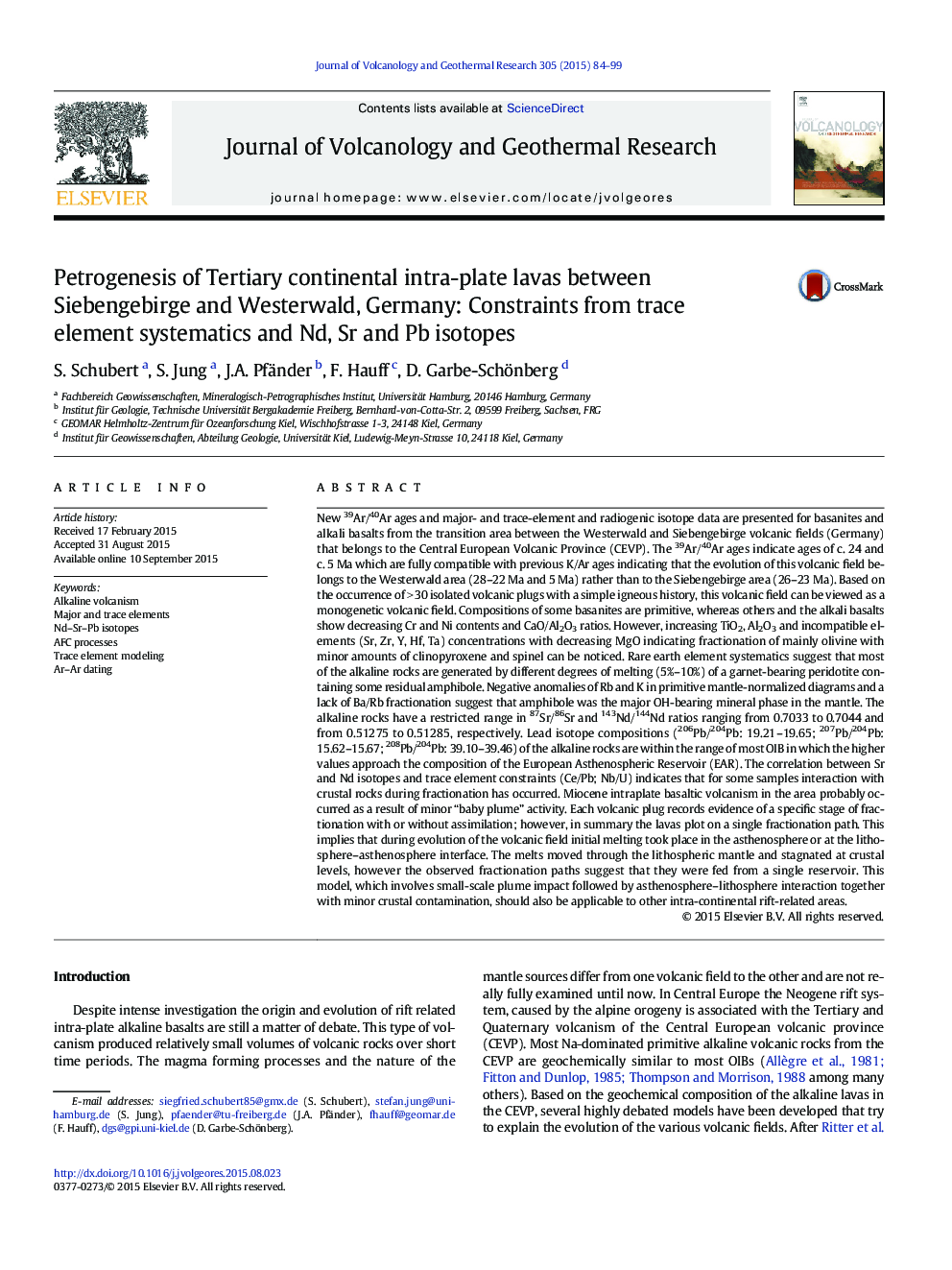| کد مقاله | کد نشریه | سال انتشار | مقاله انگلیسی | نسخه تمام متن |
|---|---|---|---|---|
| 4712812 | 1638317 | 2015 | 16 صفحه PDF | دانلود رایگان |

• Twenty-six samples from single volcanic plugs from the area between Siebengebirge and Westerwald are described.
• New 39Ar/40Ar whole rock ages and major- and trace-element and radiogenic isotope data are presented.
• Fractional crystallization and crustal contamination processes are modeled using trace and major elements.
• Partial melting processes are modeled using REE trace element ratios and P–T estimates are presented using geothermobarometric calculations.
New 39Ar/40Ar ages and major- and trace-element and radiogenic isotope data are presented for basanites and alkali basalts from the transition area between the Westerwald and Siebengebirge volcanic fields (Germany) that belongs to the Central European Volcanic Province (CEVP). The 39Ar/40Ar ages indicate ages of c. 24 and c. 5 Ma which are fully compatible with previous K/Ar ages indicating that the evolution of this volcanic field belongs to the Westerwald area (28–22 Ma and 5 Ma) rather than to the Siebengebirge area (26–23 Ma). Based on the occurrence of > 30 isolated volcanic plugs with a simple igneous history, this volcanic field can be viewed as a monogenetic volcanic field. Compositions of some basanites are primitive, whereas others and the alkali basalts show decreasing Cr and Ni contents and CaO/Al2O3 ratios. However, increasing TiO2, Al2O3 and incompatible elements (Sr, Zr, Y, Hf, Ta) concentrations with decreasing MgO indicating fractionation of mainly olivine with minor amounts of clinopyroxene and spinel can be noticed. Rare earth element systematics suggest that most of the alkaline rocks are generated by different degrees of melting (5%–10%) of a garnet-bearing peridotite containing some residual amphibole. Negative anomalies of Rb and K in primitive mantle-normalized diagrams and a lack of Ba/Rb fractionation suggest that amphibole was the major OH-bearing mineral phase in the mantle. The alkaline rocks have a restricted range in 87Sr/86Sr and 143Nd/144Nd ratios ranging from 0.7033 to 0.7044 and from 0.51275 to 0.51285, respectively. Lead isotope compositions (206Pb/204Pb: 19.21–19.65; 207Pb/204Pb: 15.62–15.67; 208Pb/204Pb: 39.10–39.46) of the alkaline rocks are within the range of most OIB in which the higher values approach the composition of the European Asthenospheric Reservoir (EAR). The correlation between Sr and Nd isotopes and trace element constraints (Ce/Pb; Nb/U) indicates that for some samples interaction with crustal rocks during fractionation has occurred. Miocene intraplate basaltic volcanism in the area probably occurred as a result of minor “baby plume” activity. Each volcanic plug records evidence of a specific stage of fractionation with or without assimilation; however, in summary the lavas plot on a single fractionation path. This implies that during evolution of the volcanic field initial melting took place in the asthenosphere or at the lithosphere–asthenosphere interface. The melts moved through the lithospheric mantle and stagnated at crustal levels, however the observed fractionation paths suggest that they were fed from a single reservoir. This model, which involves small-scale plume impact followed by asthenosphere–lithosphere interaction together with minor crustal contamination, should also be applicable to other intra-continental rift-related areas.
Journal: Journal of Volcanology and Geothermal Research - Volume 305, 15 October 2015, Pages 84–99